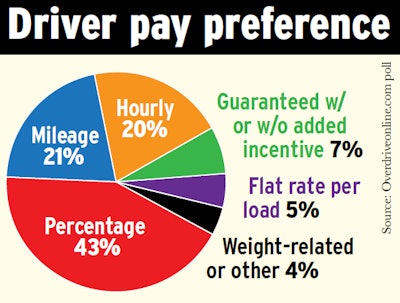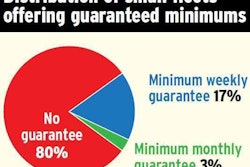Previously in this series: Guaranteed pay making waves in driver compensation
Tank hauler Don Christner pulls for a small fleet contracted to the Linde company, hauling industrial gases. The fleet has had a minimum guarantee of around $600 a week in place for as long as he can remember. Christner says he’s never actually had to take that guarantee in his more than 16 years there. If you call in to the terminal and “they tell you we don’t have any loads this morning,” Christner explains, “you just show up and have a few cups of coffee and talk a bit, and you’ll be going somewhere.”
 Trucker-photographer Don Christner also contributes to the Overdrive Extra blog.
Trucker-photographer Don Christner also contributes to the Overdrive Extra blog.Guaranteed-minimum plans born in more recent years, though, have generally higher minimums. It’s common to see offers of $1,000 a week, in some cases structured as $200 daily as long as the driver is available to work.
Flatbed fleet Boyd Bros., headquartered in Clayton, Alabama, has a basic guarantee of $1,000 weekly in place fleetwide, up from $900 late last year, says Lori Furnell, Boyd communications vice president. As with many similar guarantees at other fleets, it’s been in place for just around two years for the company’s roughly 400 company drivers. About a third of the 600 total haulers are owner-operators or in lease-purchase or straight-lease programs where no guarantees apply.
Furnell adds that most haulers at Boyd have opted for percentage pay lately. Given the rise in freight rates, operators on percentage average “a few hundred dollars more per week,” she says.
 Asked what principal base pay structure they’ve most preferred through their careers, drivers and leased operators among Overdrive’s online readers choose percentage over mileage two to one. Except for the mileage/percentage percentages being flipped, distribution of all the poll’s choices is roughly analogous to what respondents to Overdrive’s compensation survey indicated they were being paid today.
Asked what principal base pay structure they’ve most preferred through their careers, drivers and leased operators among Overdrive’s online readers choose percentage over mileage two to one. Except for the mileage/percentage percentages being flipped, distribution of all the poll’s choices is roughly analogous to what respondents to Overdrive’s compensation survey indicated they were being paid today.Smokey Point Distributing, detailed in the previous piece in this series, isn’t the only flatbed carrier to pitch a pay package as a salary in recent months. Flatbed spot market demand has shown incredibly tight conditions and upward pressure on rates in the wake of the December and April compliance deadlines for the electronic logging device mandate.
Boyd, too, made something of a splash early in the year with the announcement of a “new kind of driving position,” in the words of Chris Cooper, the company’s president and chief executive officer. Driving for Boyd’s “Mission Fleet” would yield a $1,300 weekly salary ($67,600 annually at 52 weeks), as well as 48 consecutive hours of guaranteed home time per week and paid sick leave and vacation.
“Creating better careers is a top goal for us,” Cooper noted at the time.
However, strict experience qualifications for participating flatbed drivers have limited participation, says Furnell. Another limiter has been geography. The new fleet’s hiring area was centered in the triangle defined by Bowling Green, Kentucky; Birmingham, Alabama; and Charlotte, North Carolina. When Furnell spoke with Overdrive in early June, just one driver was a part of the Mission Fleet.
Small fleet Eagle Express Inc. of Canton, Michigan, transitioned from a brokerage operation when it bought its first trucks in 2014. It immediately offered its employed drivers who were available five days of the week a $1,000 guarantee that fleet owner Leander Richmond says he’s been thinking of boosting to $1,200. Its primary intention is to encourage five-day weekly availability. Most drivers spend weekends at home, he says.
 Guaranteed pay isn’t limited to large fleets. Eagle Express, which owns this truck and seven others, put a $1,000 weekly guarantee in place when it bought its first trucks in 2014. Fleet owner Leander Richmond recently completed an order of 10 new power units.
Guaranteed pay isn’t limited to large fleets. Eagle Express, which owns this truck and seven others, put a $1,000 weekly guarantee in place when it bought its first trucks in 2014. Fleet owner Leander Richmond recently completed an order of 10 new power units.Richmond believes the minimum also helps ensure stable income no matter what happens on the road — for instance, a driver “sitting in a truck stop for three days” waiting on a load. “Never had that happen, but when we have to meet the weekly commitment … sometimes it motivates us to do things to keep drivers happier,” whether taking loads to reposition a hauler toward better opportunities or deadheading drivers (at 43 cents per mile) home or to better freight areas. Eagle Express pays 50 cents per loaded mile.
Richmond says it was challenging to meet the minimum weekly pay at first, but not so any longer. His drivers’ average pay is $1,213, he says, and $1,410 is the highest average for any one week.
Regional OTR fleet Osborne Logistics, located in Fairfield, Ohio, has started offering its company drivers a flat pay scheme similar in level to Richmond’s minimum — $210 per day they are available for work. The structure has been in place for about two years, says Brant Osborne, chief operating officer.
This is a truly flat pay offering, with no mileage benefit for exceeding any minimum. Osborne believes the plan helps make up for pay hits from breakdowns, bad weather, detention and other service interruptions. “I can’t remember the last time one of these drivers quit,” says Osborne, referring to those within the program. Osborne believes there also are safety benefits: “They feel less pressure to push.”
Most drivers are home every other weekend, and not being home every weekend earns them an additional $11,000 per year, or about $60,000 annually. It’s also great for the driver’s family. “They know what to expect,” Osborne says.
Echoing this contention is Smokey Point driver Dereik Rich, who’s based in Southern California but when we talked was planning a move to Washington State where the fleet is headquartered. Rich was making around $31,000 annually as a local driver for Smokey Point. Then he chose to take advantage of the $65,000 base salary for OTR drivers announced in May.
“I’ll be making more money than I’ve ever made in my lifetime,” the 43-year-old says. When Rich told his wife the salary figure – and that it would be guaranteed – “I thought she was going to break down” in tears of joy.
When the notion of guaranteed salary pay was first broached with Smokey Point drivers as the company began a pilot program with a few drivers, $54,000 was the annual amount, says company CEO Dan Wirkkala.
“We were paying all the accessorials” such as detention and/or layover pay on top of the guarantee, he adds, similar to how drivers were paid in the standard mileage program.
But Wirkkala and company chose to ditch most traditional accessorials and boost the pay guarantee, adding an end-of-year mileage and fuel bonus and some other incentives, as a way to “make it simple, make it obtainable, with no smoke and mirrors. This industry [as it relates to company drivers] is full of smoke and mirrors.” How many recruiters, Wirkkala asks, “sit around and discuss accessorials and bonus programs and structure them so that they look great to a driver so recruiters can market them” — only to avoid paying them as much as possible?
The $65,000 figure for solo drivers at Smokey Point ($75,000 for teams) assumes 9,900 monthly miles, or 118,800 annually (equating to almost 55 cents per mile). It pays out whether or not the mileage figure is hit. Anything above that mileage is paid out with an end-of-year bonus based on the driver’s rate of pay, itself based on tenure with the company. Overdimensional or hazmat loads are paid a per-mile accessorial on top of the salary, adding an incentive for Smokey Point operators to haul those loads.
Richmond also adds a special incentive to his $1,000 five-day minimum guarantee at Eagle Express, calculated on a daily basis for short-haul loads completed in a single day. If they’re so short as to be able to do two picks and drops, Richmond calculates the day’s $200 guarantee on a per-load basis. That delivers $400 to the driver for the day, given short mileage and load/unload times eating up the clock might shut a driver out of any potential to beat the minimum $200 on base miles pay alone.
 Smokey Point Distributing company driver Dereik Rich, with his grandson in the seat of the 2013 Freightliner Cascadia Rich drives, believes a move to the fleet’s salary program will more than double his former pay for doing local hauling work for the company. “Not many companies do a salary for their drivers,” Rich says. “I see this taking off, Smokey Point being a leader in setting a new precedent.”
Smokey Point Distributing company driver Dereik Rich, with his grandson in the seat of the 2013 Freightliner Cascadia Rich drives, believes a move to the fleet’s salary program will more than double his former pay for doing local hauling work for the company. “Not many companies do a salary for their drivers,” Rich says. “I see this taking off, Smokey Point being a leader in setting a new precedent.”Of drivers involved in the pilot program with Smokey Point, Wirkkala says several are on track, if they keep up current levels of production through yearend, to bag a $16,000-$24,000 bonus. At the top level, that’d put a Smokey Point company driver at nearly $90,000 for the year, or nearly $100,000 for a team driver.
That’s getting closer to where employee driver pay would be had it adjusted upward at the rate of inflation since the 1980s, when it began to fall precipitously relative to the inflation rate. Three years ago, carrier pay package analyst Gordon Klemp noted average driver pay would have been $115,000 at that time had it kept up with inflation from 1980.
What’s in it for any fleet to guarantee pay? The obvious benefit is to recruit and retain “good, solid professionals,” Wirkkala says. “Everybody in the fleet has a predictable income but the truck driver, and it’s just wrong. We’re going to change that.”
Wirkkala expects about half of the company’s drivers “will migrate over to the new salary package” and that many of its senior drivers, earning north of $75,000 in many instances under the base mileage package, will stay put. —Linda Longton contributed to this report.
Next in this series: No guarantees for fleets trying guaranteed pay










